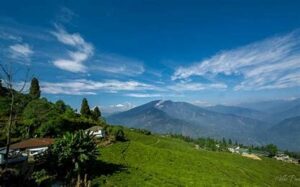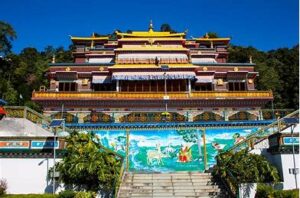The Pang Lhabsol Festival of Sikkim is a celebration of shared cultural heritage. It is also commonly known as ‘Pang Lhabsol’. It is a significant cultural affair celebrated primarily by the Bhutia and Lepcha communities of Sikkim. This annual festival is usually observed on the 15th day of the seventh month of the Tibetan lunar calendar. It holds profound cultural and religious significance for the tribes living here.
In traditional Lepcha beliefs, the mountains, rivers, and forests are considered sacred. They believe that spirits are associated with these natural elements. They have a deep connection with nature, and their rituals often involve seeking harmony with the environment. Bhutias too, believe in various deities, spirits, and protective forces. They often engage in rituals and prayers to seek blessings and protection from these spiritual entities.
Origin
The festival is a representation of the ancient belief systems of the Bhutia and Lepcha tribes. These two indigenous communities have a deep cultural attachment to their state. Both tribes have their unique traditions, languages, and religious practices. However, their continued living has showcased assimilation when it comes to honouring festivities such as the Pang Lhabsol festival.
Timing and Significance
Pang Lhabsol usually falls in late August or early September according to the Gregorian calendar. It syncs with the harvest season in the region. The timing of the festival worships the mighty Mount Kanchenjunga. As the third-highest peak in the world, it symbolizes the guardian deity of Sikkim. The festival’s timing also marks the end of the monsoon season and the beginning of the harvest, making it a time of gratitude and celebration for the blessings of nature.
Religious Significance
The Pang Lhabsol Festival in Sikkim holds profound historical and religious significance as it serves the beliefs of the people residing here. It is believed to be a commemoration of the legendary deeds of the respected third-century Buddhist saint, Lhatsun Chenpo.
This annual celebration has its foundation deep in folklore. It recounts the miraculous acts that Lhatsun Chenpo is also regarded as the patron saint of Sikkim. Miraculous acts attributed to him are recited in this festival to honor and remember him.
Historical Significance
According to the common narrative, Lhatsun Chenpo undertook extraordinary measures to safeguard the land and its inhabitants from evil spirits and natural calamities. The festival takes place through its ancient rituals, ceremonies, and cultural events. Through these, the local community comes together to offer prayers to the saint.
Devotees and followers chant this folklore in the name of divine energy. It is believed that these prayers provide continued spiritual protection to the land of Sikkim. Their folklore provides them with guidance and strength to deal with the problems of their society. The atmosphere is permeated with a sense of gratitude and awe as the whole community looks up to him.
The Pang Lhabsol Festival depicts Sikkim’s cultural heritage and showcases how influential Lhatsun Chenpo’s legacy is. It is a harmonious blend of history, spirituality, and communal celebration.
Cultural Relevance and Rituals
The festival is set apart from others by its colorful processions, traditional dances, vibrant costumes, and elaborate rituals. All of these are accounted for to pay a respectful homage to the local deities and ancestors.
This festival also recalls the signing of the Blood Treaty. This treaty restored the brotherhood between the two tribes and every year, they rejoice and deepen this bond.
The highlight of Pang Lhabsol is the masked dance performance known as ‘Chaam.’ Masked dancers re-enact scenes from Buddhist mythology and local legends.
A Warrior dance is presented by the performers stepping into a dance form that describes the war cries. The end of the ceremony is marked by the Pangted Dance by the monks and the non-monks. They are dressed as the dharma protectors who dance in joy while offering prayers.
Cultural Significance
Pang Lhabsol serves as a platform for the Bhutia and Lepcha communities to showcase their rich cultural heritage and strengthen their bonds of kinship and community. Through traditional rituals, folk dances, and communal feasting, the festival reinforces a sense of belonging and pride in one’s cultural identity.
Modern-Day Celebrations
In recent times, the state of Sikkim has welcomed changes. The Pang Lhabsol Festival too has evolved into a grand affair, attracting tourists and visitors from across the globe. The festival not only preserves the cultural heritage of Sikkim but also serves as a catalyst for tourism and economic development in the region.
In contemporary Sikkim, the Pang Lhabsol Festival continues to thrive as a celebrated event. It has seamlessly blended tradition with modernity. The celebrations take place for several days, marked by traditional cultural activities and rituals. The festival typically kicks off with ceremonial prayers and offerings at monasteries. Buddhist monks lead the chanting as the devotees follow the rituals of the ancient past.
These religious observances set the spiritual tone for the festivities. It symbolizes the collective respect for their mystical deity. As the festival progresses, the atmosphere shifts towards energetic performances. Various traditional depictions, showcasing traditional music, dance, and theatrical representations of the saint’s legendary deeds are performed.
The streets of Sikkim come alive with processions featuring its history and enactments of various scenes from Lhatsun Chenpo’s life. The participants are usually dressed in bright-colored traditional attire to showcase their joy.
Today, it represents more elements than mere cultural preservation; it reflects the dynamism of modern Sikkimese Society. reflecting the dynamism of modern Sikkimese society. During festivities, local markets are packed with diverse selling handicrafts, local delicacies, and souvenirs.
Additionally, the festival has become an occasion for the display of Sikkimese artistry and innovation, with modern interpretations of traditional performances and creative expressions finding a platform. There are also some educational initiatives and awareness programs that the locals take upon themselves to preserve the cultural heritage associated with the festival and impart its significance to the younger generation.
The Pang Lhabsol Festival is Sikkim’s way of going back to its cultural roots while adapting to the dynamics of the contemporary world. It fosters a sense of community, pride, and continuity across generations.
Unravelling a billion untold stories, one chapter at a time, Humans of Northeast takes you on a discovery through vibrant Northeast India – a land rich in people, places, and culture. Ready to immerse yourself in more such stories? Visit our page HONEI to read more about narratives that inspire and uplift.




